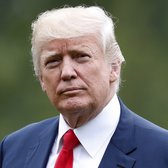Provide the U.S. Air Force with 1,200 fighter aircraft
Donald Trump
"We will build an Air Force of at least 1,200 fighter aircraft, which the Heritage Foundation again has shown to be needed to execute current missions."
Trump-O-Meter

Compromise
In 2016, the Air Force had 1,143 fighter jets. The most recent count reported by the Congressional Research Service puts the number at 1,186, for a gain of 43 aircraft since President Donald Trump took office.
That total is pretty close to Trump's goal, and a slightly later tally than the one used by the Congressional Research Service suggests the goal has been met. The conservative Heritage Foundation shows 1,232 fighter jets.
But the count obscures a key concern.
"Air Force aircraft remain quite old," said the Heritage Foundation's Dakota Wood.
Wood, a senior defense researcher, credits Trump with supporting funding that has replaced aging planes and increased the percentage of the Air Force that is combat-ready.
Still, in 2018, the average age of a fighter or attack jet was 27 years. And according to Air Force data, in 2019 less than three-fourths of the fighter jet inventory was ready at a moment's call.
The Heritage Foundation's latest assessment found that even though the Air Force budget climbed by 25% since Trump took office, "the Air Force has had little measurable success in using that funding" to solve critical problems.
By the foundation's count, the Air Force has 951 "combat coded" fighters. It said 1,200 are needed.
We rate this a Compromise.
Congressional Research Service, Defense Primer: The United States Air Force, Jan. 21, 2020
Congressional Research Service, Defense Primer: The United States Air Force, Dec. 13, 2016
U.S. Air Force Office of Public Affairs, Aircraft inventory and readiness 2019, June 26, 2020
Flight International, World air forces 2020, accessed June 10, 2020
Heritage Foundation, U.S. Air Force, Oct. 30, 2019
Heritage Foundation, Index of military strength: U.S. Air Force, 2016
Air Force Magazine, Breaking Down USAF's 70-Percent Overall Mission Capable Rate, May 19, 2020
Air Force Times, Aircraft mission-capable rates hit new low in Air Force, despite efforts to improve, July 26, 2019
Email exchange, Dakota Wood, Senior Research Fellow for Defense Programs, Heritage Foundation, June 22, 2020
Email exchange, Thomas G. Mahnken, president and CEO, Center for Strategic and Budgetary Assessments, June 23, 2020
Candidate Donald Trump said he would rebuild the Air Force and in a major foreign policy speech, he put a number on that.
"We will build an Air Force of at least 1,200 fighter aircraft," he said Sept. 7, 2016.
Trump's budget calls for an additional $54 billion for the base defense budget, or a total of $603 billion in FY 2018.
We are at the start of the budget process. It starts in the House and then passes over to the Senate, so we can't go beyond noting that Trump has offered a down payment on his promise.
That said, the Republican-controlled House Armed Service Committee voiced its concern with Trump's numbers. In a letter to the House Budget Committee, it said the money wouldn't be enough.
"That level of funding will not accomplish the administration's goals," chair Mac Thornberry, R-Texas, wrote. "Instead, we fear that it would unintentionally lock in a slow fix to readiness, consistent with the Obama Administration's previous position, from which we would not be able to dig out."
Thornberry said that about $640 billion would be needed to begin the process of repairing and rebuilding the country's military.
Todd Harrison, a fellow at the Center for Strategic and Budgetary Assessments in Washington, echoed the House committee's overall conclusion. The $54 billion would do little, he said.
"Most of it will be needed to cover cost growth in the current force and pay for the backlog of training and maintenance that has built up over the past few years," Harrison said.
By his count, to make good on the expansion Trump described during the campaign, Washington would need to spend $80 to $100 billion more in 2018 and then stay at that level.
Trump is also seeking an extra $25 billion in FY 2017. That would help him in his efforts, but still fall well short.
Harrison also emphasized that Trump, like President Barack Obama before him, needs Congress to go along with blowing through the budget caps required by the 2011 Budget Control Act. That is a considerable hurdle.
We'll see how the numbers shake out over Trump's term in office. For now, we rate this promise In the Works.
Donald Trump, Remarks on military readiness, Sept. 7, 2016
White House, America First: A Budget Blueprint to Make America Great Again, March 13, 2017
House Armed Services Committee, Letter to House Budget Committee, March 3, 2017
Congressional Research Service, The Trump Administration's March 2017 Defense Budget Proposals: Frequently Asked Questions, April 3, 2017
Email interview, Todd Harrison, fellow with the Center for Strategic and Budgetary Assessments, April 19, 2017